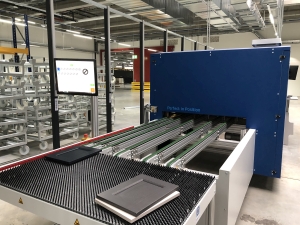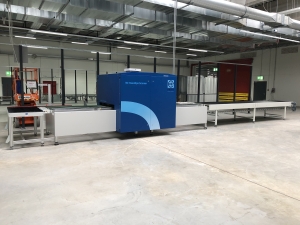HAWKEYE 3D scanner, parts identification in seconds after the painting process in the furniture industry - Perfect in position



In times of inflation and declining purchasing power for consumer goods, furniture production in Germany is facing many challenges. This applies both to the furniture supply industry and to furniture production companies. Many companies are using the economic pressure positively, defining new goals and are ready for an “internal” reorganisation. Benchmarks such as employee satisfaction and health, reduction of throughput times in production through more modern machines and processes, sustainable and efficient use of materials and increased effectiveness are being analysed and critically evaluated. Customer orientation also has a major influence; the focus here is on the fulfilment and flexibility to meet the increasingly individual wishes of end consumers.
In the furniture industry, the identification of lacquered components, e.g. kitchens, kitchen worktops, lacquered and foil fronts, frame fronts for solid wood fronts with panelling or lacquered and printed glass panes, which are processed automatically in a surface lacquering system or manually by hand, represents a significant challenge, especially if they do not yet have clear identification by means of a barcode or adequate systems after the lacquering process. To date, the components have often been placed anonymously on a work surface. This situation requires precise and efficient categorisation by the operator in order to correctly identify the components and pass them on in the production process.
The solution to this challenge is a scanner from HECHT in Besigheim. In this scanner, called HAWKEYE, the components are placed manually or automatically on a conveyor system with belt drive in front of the scanner and conveyed through the scanner. The scanner is able to recognise a wide range of features: Colour, length, width, thickness, contour features such as radii, slats or frames through to special surface characteristics such as grooves or dowels. In addition to recognising the physical properties, the preset selection in HAWKEYE also enables the assignment of component groups (e.g. fronts or carcass parts) and the corresponding colour group (paint types of the same colour). The colours and professional cross-sections are taught directly on the machine.
The components are fed to the scanner in mixed colours and mixed profile cross-sections (e.g. front models) one after the other in a chaotic manner.
The colour recognition (LAB value), dimensional measurement in target/actual comparison, profile determination, surface finish, thickness, measurement of corner radii, glass openings, grooves and dowels are carried out in a single pass in a matter of seconds.
For special colours and special components, the search features can be narrowed down using manual parameters.
The actual part identification is carried out by (AI-based) software from HECHT, which assigns unique data to the components based on the recognised features, which are then searched for and assigned in the database tables of the production database. This gives each part its unique part ID from the production database. This is then either printed and affixed as a barcode label or otherwise linked to the part.
This assignment ensures that each component can be correctly routed and allocated in the subsequent production process. By identifying each part in this way, the completeness of each order is also checked.
In summary, this type of part identification is valuable for increasing efficiency and accuracy in part identification after the painting process, minimising the number of existing employees and optimising sustainability and costs.
The ongoing change within the furniture industry inevitably leads to a “production smoothing” through innovative technical possibilities and the corresponding efficiency of the processes, it is literally forced to implement this promptly in order to meet future challenges.
It is increasingly difficult to predict where the journey will take us. Global requirements and changes have ever shorter cycles, which the furniture industry has to face.
We at HECHT are happy to help you find the optimum solutions for your application and achieve the best possible results.




